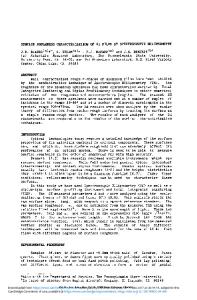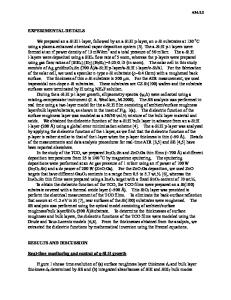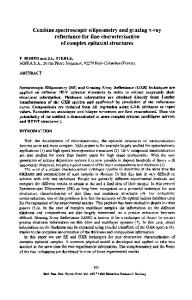Spectroscopic Ellipsometry as a Non-Destructive Technique for Characterization of Atomic-Scale Interfaces
- PDF / 321,817 Bytes
- 6 Pages / 420.48 x 639 pts Page_size
- 8 Downloads / 301 Views
SPECTROSCOPIC ELLIPSOMETRY AS A NON-DESTRUCTIVE TECHNIQUE FOR CHARACTERIZATION OF ATOMIC-SCALE INTERFACES J.L. STEHLE *, J.P. PIEL *, J.H. LECAT *, C.PICKERING **, L.C. HAMMOND *** * SOPRA, 26/68 rue Pierre Joigneaux, 92270 BOISCOLOMBES,FRANCE ** Royal Signals and Radar Establishment, St Andrews Road, Malvern, Worcs WR14 3PS, U.K *** ARIES/QEI, Concord MA 01742, USA. ABSTRACT Analysis of oxide interfaces with semi-conductor substrates, or indium gallium arsenide, such as crystalline silicon, and electrical in processing phosphide is critical performances. Interfaces can be characterized by spectroscopic ellipsometry (SE), which has a wide spectral range (1.3 to 5.3 eV ) allowing an optical penetration depth of 10 nm to a few microns. A multilayer stack can be characterized in terms of its layer thicknesses and composition. These physical parameters Linear must be calculated through a mathematical model. used to minimize the differences regression analysis is If between the measured spectrum and the calculated model. necessary, an interlayer can be introduced into the model to This can be complemented by a new method enhance the fit. involving calculation of apparent index values which amplifies interface sensivity allowing the thickness to be measured to better than 2 Angstroms. Examples will be given. I : INTRODUCTION interfaces have an important role. In semi-conductors, Their presence can seriously modify the electrical properties of many electronic and opto-electronic devices. Therefore, the need for appropriate characterization techniques is important. the advantage of being a ellipsometry has Spectroscopic sensitive and non-destructive procedure, which can be adapted examples of the (1). Detailed to in-situ measurements sensitivity of this technique will be given. II
: BASIC PRINCIPLES - INSTRUMENTATION
the The principle of spectroscopic ellipsometry is analysis of the polarization state of a collimated light beam to be surface reflected from the for each wavelength is characterized. The light, emitted by a Xenon arc source, collimated by a spherical mirror and then modulated by a rotating polarizer. After reflection on the sample, the state modified. This effect is of polarization of the light is related to the sample properties : thickness and composition of each layer. The reflected beam passes subsequently through a second achieved by using a polarizer. Spectroscopic scanning is double monochromator with a grating and a prism. The detector
Mat. Res. Soc. Symp. Proc. Vol. 159. ©1990 Materials Research Society
460
(photomultiplier) produces a sinusoidal signal and its phase and amplitude are obtained from an Hadamard transform. From these values, the computer calculates and displays for each wavelength the two ellipsometric parameters Tan W ( amplitude ratio ) and Cos A ( phase difference) III:
BASIC PRINCIPLES - THEORY
As spectroscopic ellipsometry is an indirect technique, a model must be chosen to interpret the change of state of polarization of the light created by the surface to be characterize
Data Loading...








